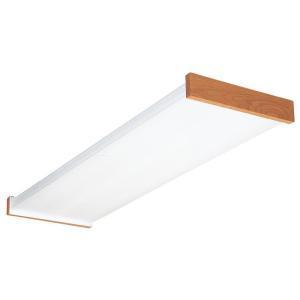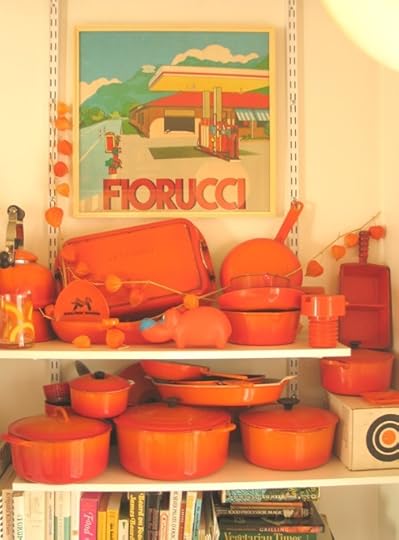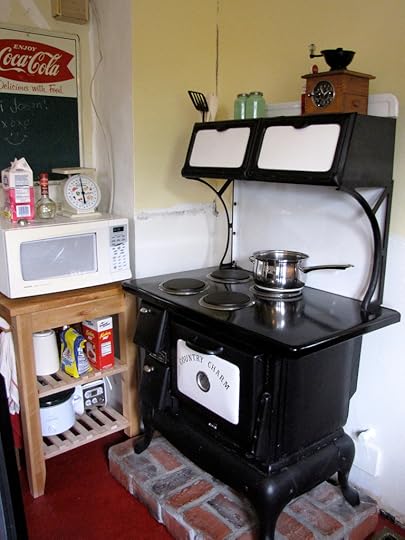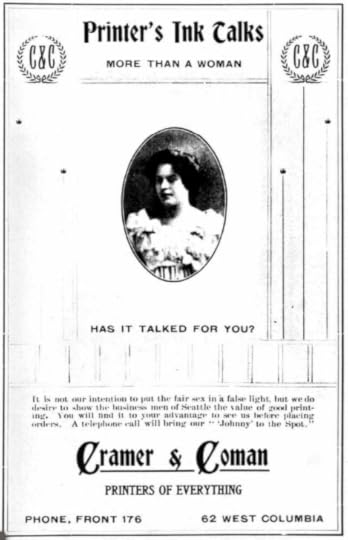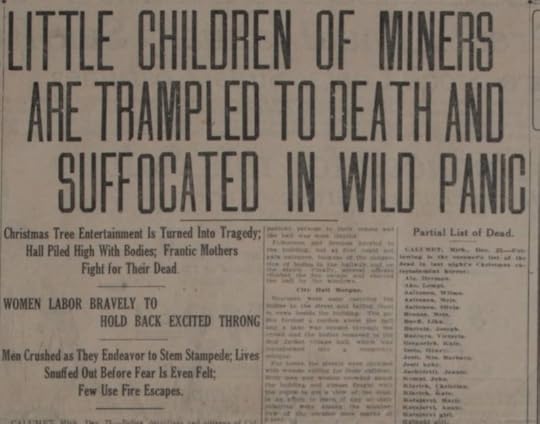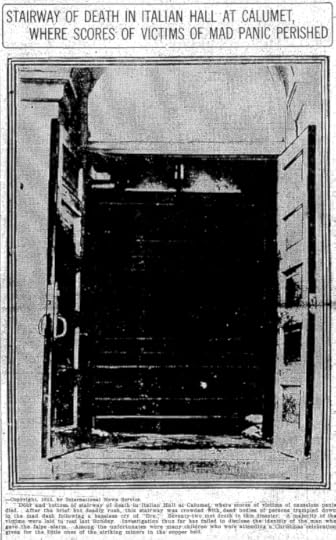Wendi Dunlap's Blog, page 3
November 19, 2014
Before and after: the bedroom project
My bedroom was bad news.
After 18 years of living in the house, the bedroom walls were still the same dingy white they’d been on the day we moved in. Only dingier. The nasty blue carpet had been partially removed, revealing plywood with random splotches of paint. The Venetian blinds were broken. And the worst thing? The horrible, awful fluorescent light fixture that blighted the ceiling. It was like this one:
Yes, one of those. In a bedroom. I hated it. And yet, for 18 years it stayed. And stayed. On as little as possible, but it stayed.
Here are a few “BEFORE” pictures of the old bedroom.
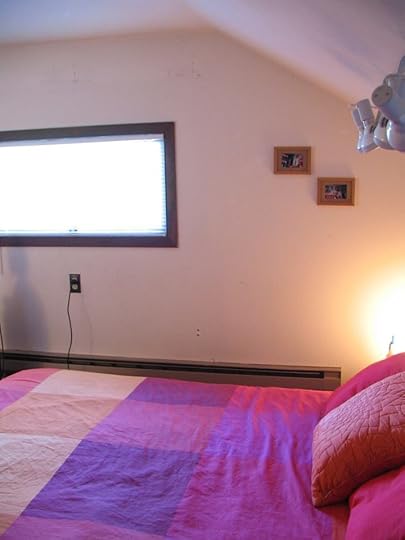
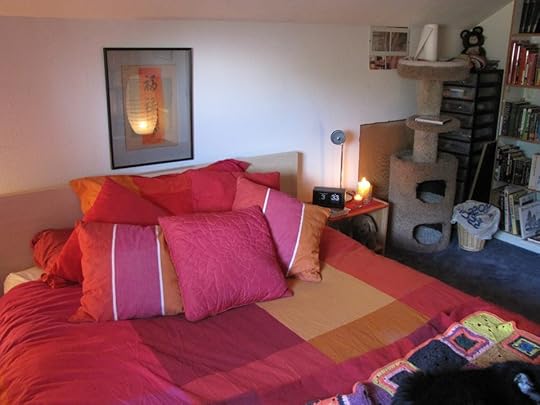
Note plywood covering big hole in the wall. Note also, horrible blue carpet. And cat tree.
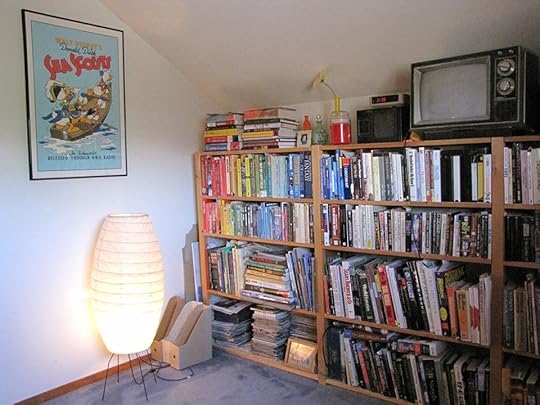
This is about as good as any part of that room ever looked. And yet… the dingy white walls, brown trim and blue carpet are not a look any room should have.
It doesn’t look like that any more!
I wanted color, warmth, and openness. I think I got it! This is the result of the 2014 redesign:
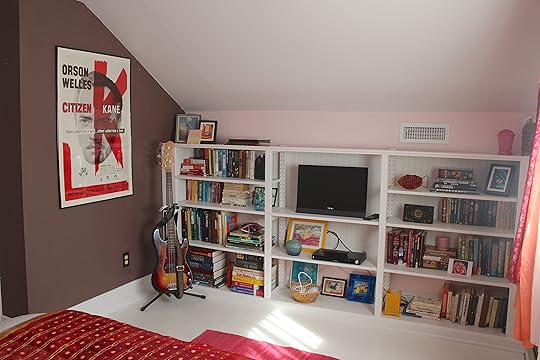
This is the same IVAR bookshelf from IKEA that was there before, in the same corner. Only now, it’s painted, has beadboard backing, and has added trim.
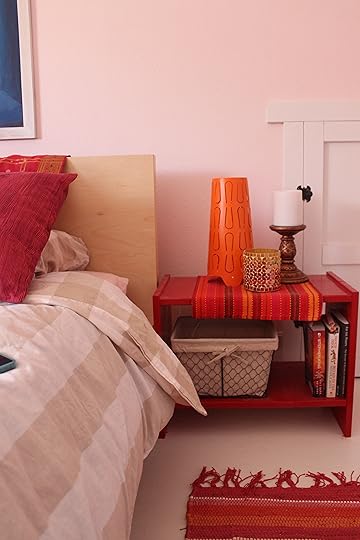
The painted red table is easier to clean than the old unfinished pine. The basket on the lower shelf hides things that might otherwise be messy.
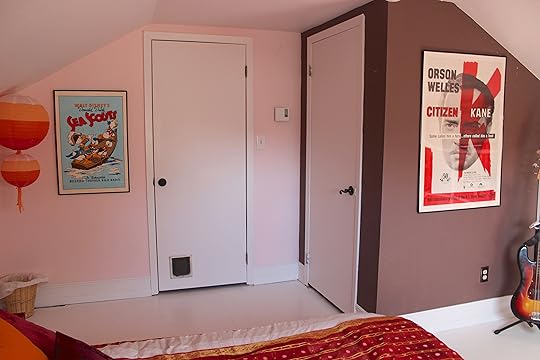
The wall around the walk-in closet is now an accent wall in a rich chocolate brown that tones down the pink of the other walls. The baseboards are wider, and the art on the walls is better proportioned to fit the space. To the eye, the walls are paler pink than they appear in this picture.
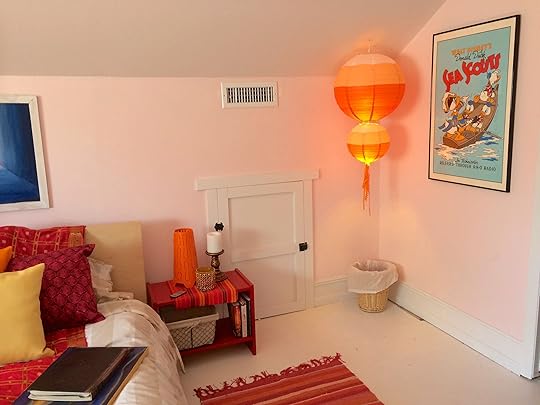
Hanging lanterns cost me a total of $5 at an end of summer clearance sale at a local drugstore. The LEDs to light them (with remote!) come from Pier 1. The tiny doorway leads to part of the attic; until now, that doorway was just a piece of unfinished plywood filling the space. Now, it goes with the rest of the house, which is a 1911 Craftsman bungalow.

The blue colors in the painting (by Seth Damm) are a necessary accent among the warm colors in the room. A sari serves as a decorative bedspread. (To the eye, the LEDs are whiter than they appear in this photo.)
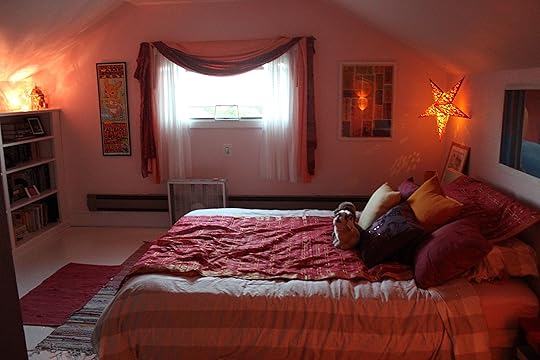
In the afternoon, lanterns with LED lights add a warm glow to the room. Even with the white floor, the room never looks cold. Two saris draped over the curtain add some panache to the plain, small window, even though the curtains cannot be kept longer because of the baseboard heater.
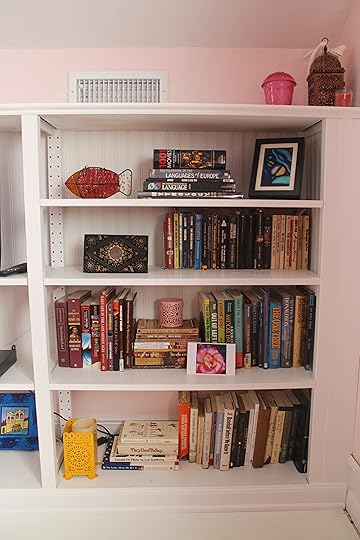
One final look at the bookcase, transformed with paint, trim, and beadboard.

The side tables are the same IKEA RAST units that were there for the last decade or more — only now, they’ve been painted a shiny red gloss. The hanging star was found at Goodwill.
So here’s what the project included:
Ripping out blue carpet
Removing old baseboards
Removing old fluorescent fixture
Priming and painting walls, floor, trim
Building and painting a door and trim for the hole leading to the attic
Painting shiny nickel light fixture to be oil-rubbed bronze instead
Repairing drywall ceiling, installing new oil-rubbed bronze light fixture
Removing/refinishing/replacing doors’ hardware
Replacing switchplates, etc.
Rebuilding baseboards into wider ones (stay tuned for more on that in a later post)
Spray painting old pine bedside tables with gloss red enamel
Adding beadboard back to old bookshelf
Adding trim to old bookshelf
Using MDF to fill in around sides of bookshelf, making it look built-in
Painting bookshelf
Decorating! Finding art, lamps and soft furnishings to suit the new room.
The project was relatively inexpensive, though like all such projects, it was still more than planned. Here’s what I had to buy (I’m sure I’m missing some things):
Floor paint
Wall paint
Trim paint
Primer
Spackle
Various painting supplies, sandpaper, etc.
Spray paint for side tables
Spray paint for light fixture and some door hardware
Baseboard material
Drywall to patch ceiling
Spray texture to blend new drywall with old
New switch/outlet plates
Hinges, etc. for new attic door
Trim for bookshelf
Beadboard for bookshelf (some I already had, some I had to buy)
MDF
A bunch of decorating stuff — lamps, duvet cover, saris for decorating, picture frames, pillows, etc. A large number of things, however, came from thrift stores.
All in all, I’m deliriously happy with how this one turned out. I love the color and warmth of the room. I wasn’t sure about the white floor, but I love it, too. The room is much easier to clean now that the carpet is gone, and it’s so much brighter with the new paint.
Special thanks to my housemate Mike who went above and beyond in helping with the project, including building the adorable tiny attic door.
March 13, 2014
Baking pans that sparkle
More kitcheny stuff — sorry, but I keep falling into a rabbit hole of interesting stuff when I research things.
Have you ever seen a pan that looked like this?

Photo by JillHannah via CreativeCommons/Flickr.
How about this?
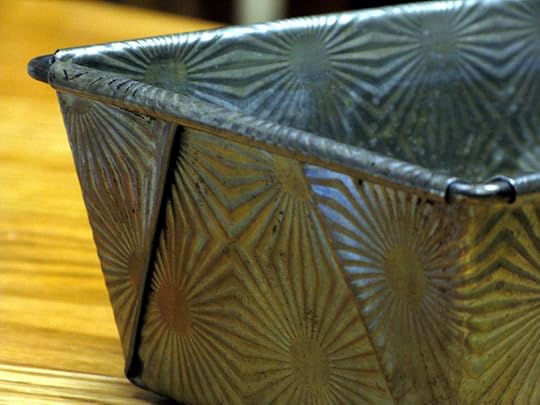
Photo by GranniesKitchen via Creative Commons/Flickr.
These are Ovenex vintage baking pans. I have never seen one in person, but stumbled on this blog post this week, showing off a beautiful assortment of these pans, all decorated with that starburst pattern. Aren’t they just gorgeous?
See more of them in this Google Images search or this Flickr search. And of course, Pinterest has a few to look at as well.
The last thing I need is something else cool to search for in thrift stores!
March 7, 2014
Thrifting pays off!
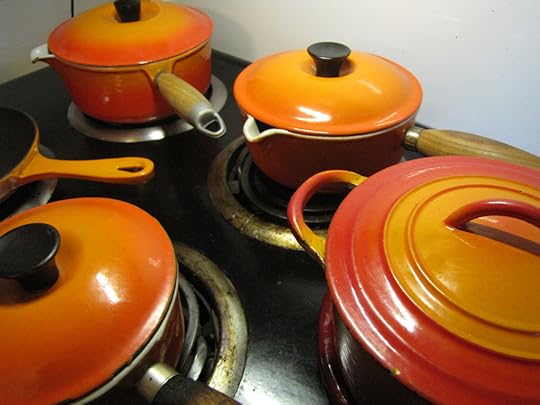 (Hmm… this is three posts in a row about either cooking pans or a stove. Perhaps I need to diversify.)
(Hmm… this is three posts in a row about either cooking pans or a stove. Perhaps I need to diversify.)
Some of you know how much I love Le Creuset enameled iron cookware. I’ve lusted after it in many a kitchenware store since I was old enough to think about furnishing a kitchen. (Sur la Table has seen me come in “just to look” a ridiculous number of times.)
It took some doing, but in almost exactly three years, I’ve managed to acquire a relatively complete set of Flame color Le Creuset pans at the local Goodwill. (Not to mention a red LC stock pot, a red LC utensil crock, a big new oval red Dutch oven by another brand which looks like a Le Creuset, a matching trivet, many cast iron skillets, and a ton of cool stuff that has nothing to do with my kitchen.)
Le Creuset is usually incredibly spendy, but the colors of the pans are irresistible. The quality is also very good. When you buy a set of Le Creuset, it’s supposed to be an investment to last for the rest of your life. You need to know that you can live with the color you choose.
Many years ago, through a screaming great deal, I bought a set of cobalt blue pans as my first ever credit card purchase. I still have the tiny skillet and a small saucepan, but the rest of the set was accidentally left behind when I moved in 1992. (Someone has my pans. Please send them home.) A few years later I got a cobalt blue Kitchenaid mixer as well, then realized I didn’t want a blue kitchen any more. Oops.
A few years ago, my ex-husband bought me a set of cherry-red LC pans. And I do love all things kitcheny and red. But the flame was also calling my name. It didn’t hurt that this picture was all over Pinterest (click the image to see the original source):
I decided that I don’t care if my pans don’t match each other — that having a bunch of different colors would be even more glorious. And especially if one of those colors was the original LC color, the flame orange that was supposedly inspired by the cauldron of molten iron that gives the company its name.
So, three years ago this month, on my last thrift store trip with my ex, I saw two beautiful flame-colored saucepans for, if I recall correctly, $12 and $13 each. I jumped on that deal so fast your head would spin. And in the three years since, through diligent thrifting, I’ve found a few more. (And, sadly, left some in the store that Goodwill decided they wanted to charge the big bucks for.) This week, I realized that I have a pretty good set of the flame cookware now. Combined with the red and the remaining cobalt blue, I’m going to have a very colorful shelf of pans. (What? You thought I’d hide them in drawers or cupboards? Never!)
Total cost of my three saucepans, one French oven, and an omelet pan? Well, I didn’t keep track, but I know no item was more than $15. Most were way less.
However, they are from Goodwill, and some of them are closer to new than others. Two of the vintage saucepans had essentially new interiors, as does the omelet pan. One of the pans had a badly damaged handle I replaced. The small French oven has had the interior worn to bare iron somehow — which isn’t really a long-term problem since I’m seasoning it like any non-enameled cast iron pan.
Most of the pans looked pretty grungy in the thrift store, which is why they were cheap. But grunge cleans off. (Uh oh. Should I be giving away the secret?) The pans really do last a lifetime and beyond, if people are willing to treat them properly.
Thank you to all the folks who didn’t want to bother cleaning their gorgeous orange kitchenware, and who gave it to Goodwill for me.  Keep your eyes open at the thrift stores — you have to go a lot, but you can, in good time, find some amazing stuff.
Keep your eyes open at the thrift stores — you have to go a lot, but you can, in good time, find some amazing stuff.
February 20, 2014
Guess which of these stoves isn’t in my kitchen anymore
Hint: not the old-looking one.
On a whim, a few weeks ago I removed the microwave from my kitchen. It took up too much space, and I realized that all I really used it for was to heat up frozen dinners I shouldn’t be eating anyway. Reheating food and cooking soups and such? That I do on the big stove. It’s better that way. (Microwaved pizza is nasty. It’s so much better when I reheat it on the pizza stone in the oven.) So I decided to try to go a few months without the microwave to see if I miss it enough to bring it back.
So far, the only time I’ve missed it much is when I was trying to de-crystallize some honey. Putting it in the microwave is the quickest way to do it. But it’s not worth keeping it around just for that.
I didn’t have a microwave until I was well into my adulthood, so I think I should be fine without it.
Anyone else given up on their microwave?
February 16, 2014
Cast iron rocks
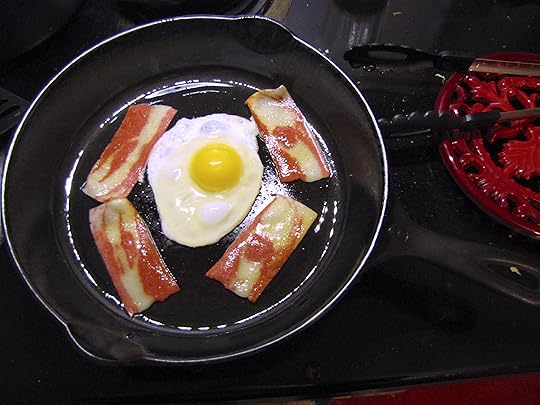
Egg and (veggie) bacon.
I love my cast iron pans.
I always heard how great cast iron was supposed to be. How a decades-old seasoning on the pan is something to treasure. How properly-seasoned pans are completely non-stick. How easy iron is to care for. And I didn’t believe any of it.
My ex-husband and I picked up a humongous cast-iron pan once, and I do mean huge. One of those giant skillets that has a second handle so you can carry it without dropping it. It was a new pan, a Lodge, completely unseasoned. I don’t recall what we did to try to season it, but we did use it at some point. I think it’s possible that all we did is start cooking in it, figuring that the seasoning would then develop. Which is sort of true. But as soon as we tried to clean it, we discovered it was a pain. It started rusting quickly, and it was too heavy to use regularly, so we gave up.
But, more recently, I’ve been converted. With good pans and the right treatment, cast iron is non-stick, and is incredibly easy to care for.
The pans
I bet when you think of cast iron you think of a rough, rustic sort of pan, right?
It turns out that modern pans aren’t like the old ones. You can get modern pans, made in the U.S.A. with reasonable quality, from Lodge. Now they come with a bit of pre-seasoning so you can use them right away. They are heavy, and a bit rough. Some other pans on the market are rougher and more rustic. You can get them to be nicely seasoned, eventually.
But the old pans — pre-1960 or so — they are a completely different beast. Old pans were more finely finished — machined mirror-smooth. They are thinner, so they are lighter weight. And being so smooth already, once you get them seasoned… well, they are amazing. Better than any modern non-stick pan. So I buy vintage pans when I can find them at the thrift store. Mostly I’ve found Wagner Ware. Sometimes they are so abused you can’t even tell what brand they are, but you get a nice surprise when you clean them up.
Caring for them
It turns out that once you get the pans ready for use by reconditioning and seasoning (both of which are thoroughly addressed at the Black Iron Blog), taking care of the pans is dead easy. Here’s what you do:
Cook your awesome meal. Eggs, fish, bacon, fried chicken, deep-dish pizza, whatever.
Let the pan cool a bit so you can handle it.
Run hot water on it. Don’t worry, it won’t rust if it’s seasoned. Rinse out some of the crud.
Wipe out the rest of the crud with a towel. If there is something you can’t get out, you can use a paste of salt and water to get it out, or a plastic scrubbie. Not one of those flat green pads. If you absolutely can’t get something out, put a bit of water in the pan and bring it to a boil. That will loosen up the stubborn crud. Wipe the pan as thoroughly as you can. Spotless.
You know what you don’t do? That’s right. Use soap. “But,” you say with a look of horror, “how can I not use soap?” Here’s why and how. Dish soap is designed to cut down grease and oil. What do you use to make a good seasoning on your pan? Grease and oil. So what does dish soap do to the developing seasoning layer? It damages it. Eats away at it. You don’t want that.
Instead, you wipe it as clean as possible. Run more hot water on it if you must. And then — you dry it off thoroughly, wipe it with the thinnest possible layer of oil, and set it on the burner, set to low, for seven minutes. This dries out any remaining water to prevent rust, and it also gets the pan temperature so damn hot that no nastiness can survive on your cast iron.
Leave the pan on the burner until the time is up. (Don’t forget it!) Then take a clean cloth or paper towel, and wipe the pan down, removing the excess oil (there will be a bit more now that the pan has heated) and leaving an even thinner layer. You want it thin, or it might get sticky. Don’t worry, even with a very thin layer, the pan will be happy. Your pan is now ready to store.
The oil you use is something that everyone has an opinion about. I seasoned my pans initially with Crisco, and I think that works just fine. But now I mostly cook with olive oil, and so that’s what I wipe the pans down with too. Olive oil isn’t supposed to be great for this, but with the technique I’ve been using, it works just fine. It does contribute to the seasoning polymer that builds up on the pan, which keeps getting better and slicker as I use it.
Keep doing this everytime you cook in the pan, and pretty soon you will have what I have — a pan that is completely nonstick, that allows you to flip an egg by shaking the pan (well — it takes some practice), that even burnt teriyaki sauce won’t stick to.
When you cook in it, heat the pan first, then add oil. This also prevents sticking. I heat it until drops of water tossed in it sizzle and jump around, then add some olive oil or any other oil I may need to use.
February 15, 2014
1902 ad: “More than a woman”
January 8, 2014
Random Pinterest pins: pink cats
For some reason there are a lot of pink cats on Pinterest. Well, more than I would have expected. Like this:
Or this:
Or these:
I think some of these may be the same cat.
The breeder who can breed actual pink kittens would probably make a fortune. You know it’s true.
January 1, 2014
“Lives snuffed out before fear is even felt”
When I was looking through the January 1, 1914 Seattle Times last night, I found some coverage about a disaster I had never heard of. 73 dead — 59 of them children — died in Calumet, Michigan, when someone shouted “Fire!” in the crowded Italian Hall where striking mine workers and their families were celebrating Christmas. There was no fire. Eight witnesses swore that the shouter was wearing a Citizens’ Alliance badge; Citizens’ Alliance was the anti-union organization funded by mine management.
Woody Guthrie wrote the song “1913 Massacre” about it:
“The piano played a slow funeral tune,
And the town was lit up by a cold Christmas moon,
The parents they cried and the miners they moaned,
‘See what your greed for money has done.’”
The Italian Hall Disaster Resource Center Facebook page maintained by Steve Lehto is posting a day-by-day report of what happened 100 years ago:
December 31, 1913 – 100 years ago today, the Coroner issued his ruling exonerating the guilty and placing the blame on the victims. The English-language papers continued blaming the unions for everything while mine management told people they would continue to investigate (which they wouldn’t). Management wanted to buy time, so their guy could get away and witnesses could be intimidated into silence. Meanwhile, the grand jury was hand-picked by management (and loaded with friends of management – it included a slew of men who admitted being members of the Citizens Alliance!) They would eventually refuse to indict anyone for any of the illegal acts against the workers. They would indict the union leadership, calling their actions a conspiracy.
Lehto is the author of a book about the disaster, Death’s Door: The Truth Behind the Italian Hall Disaster and the Strike of 1913 .
.
Last month, PBS aired a documentary about the strike and the tragedy, Red Metal: The Copper Country Strike of 1913. You can watch it online.
November 3, 2013
My surnames book is out!
 It may not be the Great American Novel, but I do have a book out as of a week or two ago. Middle English Surnames in West Yorkshire is a book version of my MA thesis, and it should be of interest to folks into genealogy, onomastics (names), language, the SCA or similar groups, or English history.
It may not be the Great American Novel, but I do have a book out as of a week or two ago. Middle English Surnames in West Yorkshire is a book version of my MA thesis, and it should be of interest to folks into genealogy, onomastics (names), language, the SCA or similar groups, or English history.
The first part of the book is an overview of surnames and the names in the Wakefield Manor court rolls. The rest of the book — most of it — is a list of all the names with etymologies and references, divided by type.
If you are looking for a medieval name for the SCA, this is a good source. Every name in the list is from the 13th or 14th century, so they are all documented during SCA period. Many of the names are from place names as well, so this is also useful when looking for a place name to use.
Here are a few places to buy it:
The CreateSpace store (I get paid more from this one.)

Amazon (paperback)
Amazon (Kindle)
It should appear in other locations soon as well.

